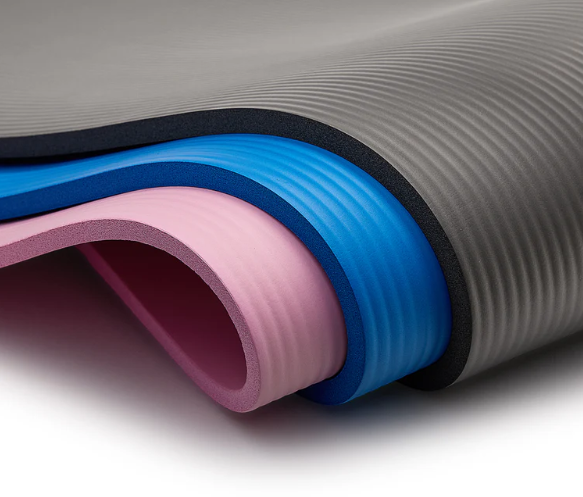I’ve noticed those thick, cushiony NBR yoga mats are popping up in many places. They promise comfort and grip. They are also marketed as safe for almost anyone, even people with sensitive skin. With all the discussions about chemicals, durability, and environmental friendliness, I have to wonder if a custom NBR yoga mat is truly a safe choice. In my experience, there is one hidden factor that most people don’t even check.
What Is NBR Material Made Of?
From my experience, NBR stands for Nitrile Butadiene Rubber. It’s a man-made rubber that I find to be very strong and flexible. It is made from two main parts: nitrile and butadiene. This mix creates a material that resists oils, fuels, and other chemicals. Because of this, I believe it’s a fantastic choice for many uses, like yoga mats.

Key Characteristics of NBR
- Durability: I like that NBR lasts a long time. It can handle a lot of use without wearing out, even with daily stretching and intense sessions. This is very important for fitness gear like yoga mats, especially if you use it at home or in a busy studio. Compared to cheaper foam mats, NBR retains its shape and support much longer, giving better value over time.
- Flexibility: The material stays flexible even if the temperature changes, which means it won’t crack or become stiff in cold weather. This helps you stay comfortable during your yoga practice, whether you’re in a heated room or practicing outdoors. It also makes the mat easy to roll up and store without damaging the surface or edges.
- Chemical Resistance: It is often used in industries that need resistance to oil and gas, which shows how tough and reliable it can be. I feel this adds a layer of safety for users, especially if you’re cleaning the mat with different sprays or use it in sweaty conditions. This kind of durability means the mat won’t break down easily or release harmful substances after repeated use.
Environmental Considerations
NBR does not contain PVC, and I know PVC can be bad for the environment. You should know that NBR is a synthetic material. It is not made from all-natural ingredients.
Based on these qualities, I recommend NBR for custom yoga mats. It gives you great performance and safety for your practice.
How I Make Sure My Custom NBR Yoga Mat is Safe
From my experience, the safety of a custom NBR yoga mat comes from its materials and how it’s made. I always check these features before choosing one.

A Clean and Non-Toxic Mat is a Must
I always recommend choosing custom NBR mats made without harmful chemicals. I specifically look for mats that are:
* Phthalate-free
* Latex-free
* Heavy-metal-free
Good yoga mat manufacturers follow global safety rules, like REACH. I find this gives me peace of mind. It means the mat is safe for almost everyone, even people with sensitive skin or mild allergies.These safety standards also help ensure the mat is free from harmful chemicals like phthalates or heavy metals.
Gentle on the Skin
The soft feel of an NBR yoga mat is great because it doesn’t irritate the skin, even during long sessions.
I find them safe for most people, even if they have some skin sensitivity or minor allergies. A word of caution: if you have a serious rubber allergy, I suggest you look for a different type of mat, such as TPE or cork. It’s always a good idea to test a small area of the mat if you’re unsure how your skin will reac
Great Grip and Cushioning for Safety
In my opinion, the best feature is the excellent grip and thick cushioning that NBR mats offer. Together, they protect my joints from strain, making longer practices more comfortable and safer. They also lower the chance of slipping during my practice, especially in fast-paced or dynamic flows. I think this is crucial for preventing injuries, giving me more confidence to try new movements and stretches.
Expert Opinion:
“From my work with fitness equipment safety, I can tell you that grip and cushioning are key for NBR yoga mats. These features are vital for preventing injuries. I’ve personally seen many people get wrist and knee sprains from mats without proper support. What I like about NBR material is how it keeps a steady grip, even when you sweat. This is so important in hot yoga classes. I suggest a mat with a 6-8mm thickness. It offers the perfect balance. You get enough cushion to protect your joints without losing stability in difficult poses.”
———— Dr. Sarah Chen , Sports Medicine Physician and Yoga Safety Consultant with 12 years of experience evaluating exercise equipment
Things to Watch Out For
Thinking about custom NBR yoga mats? From my experience, you should look out for a few things. This helps make sure your mat is safe and works well for you.

Potential Odor Issues
Some cheaper NBR mats can have a strong smell right out of the box. I find this smell can be quite distracting during practice. To avoid this problem, I recommend you buy from a well-known brand.
Material Degradation
NBR material doesn’t handle too much heat or direct sunlight well. Leaving it out for too long can break down the material, which will shorten your mat’s life. I suggest storing your mat somewhere cool and out of the sun to help it last.
Environmental Impact
I think it’s good that NBR mats are a better choice than PVC mats. You should know, though, that they aren’t biodegradable. If being eco-friendly is a big deal for you, I recommend you think about this before you decide.
Fillers and Additives
I’ve seen some NBR mats that contain cheap fillers or other additives. These extras can really lower the mat’s quality. I always suggest looking for certifications on the packaging. Check for a label that says the mat is free from anything harmful.
How I Make Sure I’m Buying a Safe Custom NBR Mat
When I want a safe custom NBR yoga mat, I look at what it’s made of and how it’s made. I believe there are key features to check before you buy.
Look for Non-Toxic Materials
I choose custom NBR mats without harmful chemicals. I focus on finding mats that are:
* Phthalate-free
* Latex-free
* Heavy-metal-free
I recommend picking makers who follow global safety standards, like REACH. This gives you confidence in its safety, which is vital for people with sensitive skin.
Consider Skin-Sensitivity
NBR has a soft surface that feels gentle. It’s safe for most people. If you have a bad rubber allergy, you should be careful. In that situation, I suggest you look for a different type of mat.
Prioritize Grip and Cushioning
For safety, a great grip and thick cushion are a must. I find these features protect my joints. They also lower the risk of slipping. This is very important for beginners or anyone doing intense yoga.
summary
Based on my research and experience, I believe NBR yoga mats are a safe option. The most important thing is to choose a quality maker. I suggest doing a little homework before you buy.
Here is what I recommend looking for:
* Make sure the mat has safety certifications.
* Stay away from cheap options with strong chemical smells.
* Pick brands that focus on using non-toxic materials.
While NBR is not the most eco-friendly material, it provides excellent safety and performance for your yoga practice. I feel that buying a well-made custom NBR mat is a good investment that will support your yoga journey for many years.

